Linen, a sustainable fabric made from the flax plant, isn’t produced on this continent. But some are hopeful a whole new industry could be on the horizon.
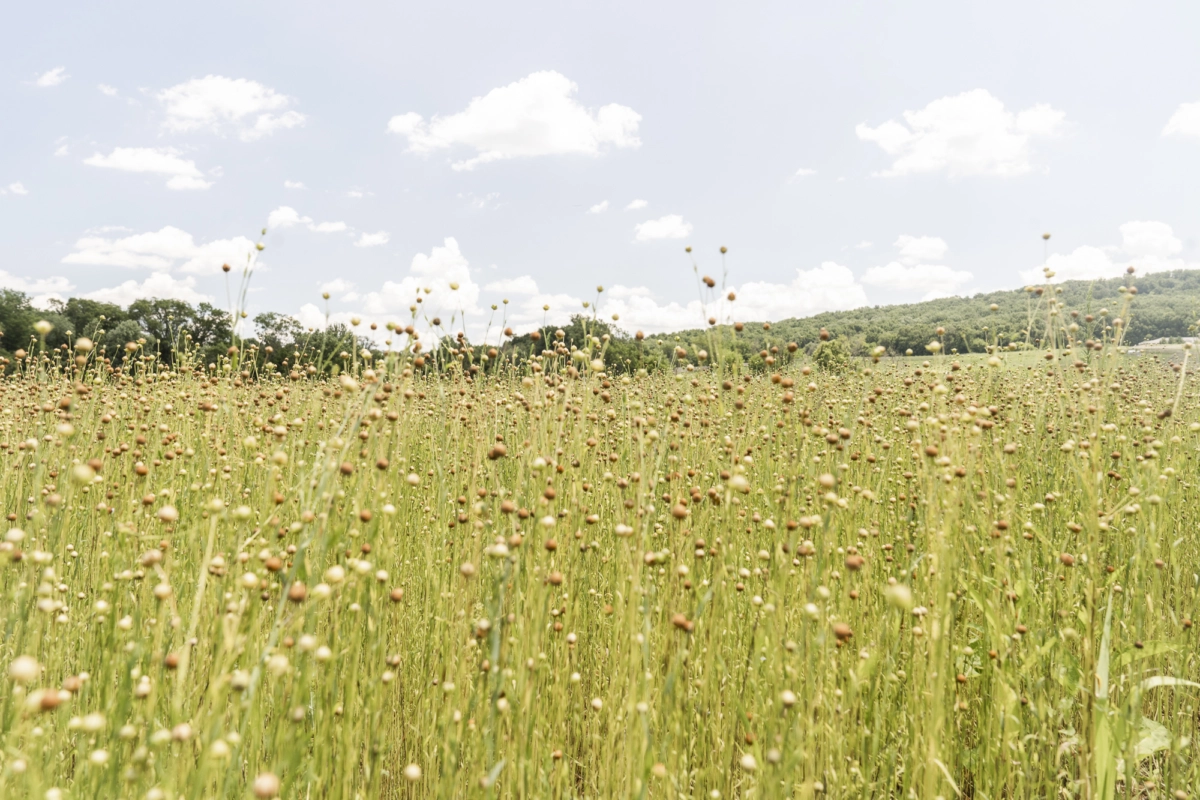
On a smattering of farms across the United States, but especially in the rainy stretches of the Pacific Northwest and the Great Lakes region, an increasing share of land is being devoted to flax.
The crop itself is hardly new. It’s most prevalent today in states such as North Dakota and Montana, where it’s grown to make linseed oil and flaxseed meal. But the varieties now springing up in places that have long been dominated by corn, wheat and soybeans aren’t meant to be used for seed. Instead, these new flax farmers are targeting the plants’ fibers.
Flax fibers are used to make products ranging from twine to banknotes. In some cases, they can even serve as a substitute for materials such as carbon fiber. Crucially, however, linen fabric is made from woven flax fibers.
“Flax is linen, and linen is flax,” says Heidi Barr, a home goods designer and co-founder of the PA Flax Project. “And it is remarkable how many people don’t know that.”
The vast majority of the world’s linen is grown in Western Europe. Most of the remainder comes from China. In North America, linen production is all but nonexistent, save for one very small mill in Nova Scotia, Canada.
The PA Flax project is one of a handful of local groups trying to reestablish commercial linen on this continent.
It all starts with education, says Barr. Demand is on the rise for sustainably made clothing and other textiles. And that’s exactly what advocates for North American linen believe it can provide.
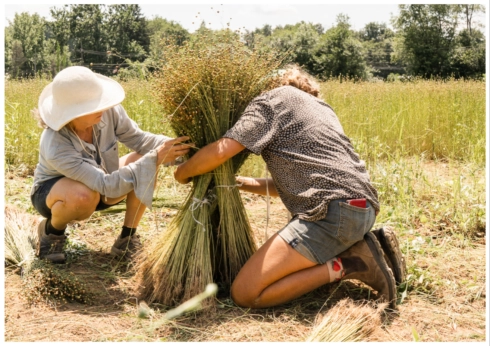
Heidi Barr and Emma De Long, the co-founders of the PA Flax Project, harvest flax at Kneehigh Farm in 2020. (Photo: Zoe Schaeffer)
Yet truly sustainable linen will be expensive, at least early on, when the supply chains are still getting up to speed. The more familiar people are with where linen comes from and how it’s made, the better it’s expected to fare in a market saturated with cheap synthetic fabrics.
“People who are working in textiles want [linen],” says Barr. “It’s so versatile, it’s so environmentally friendly, and then there are all these benefits to our small and mid-sized farmers. … I just think that making that connection of, ‘Oh, this fabric can come from this plant,’ is like magic to people.”
Over the past several years, the vision of a sustainable North American linen industry has started to crystallize. Groups like Barr’s are well aware of the many challenges that stand in their way, but they also believe each one can be overcome.
Even under the best of circumstances, though, bringing linen goods to buyers will require a lot of innovation, money and time.
The limits of traditional methods
Linen has a long history in North America. Early European settlers brought flax with them and used rudimentary tools to process it. After extracting the fiber from the plant using a flax brake—a sturdy contraption that looks sort of like a short wooden guillotine—they combed it into usable strands, spun it into thread, wove it into fabric and then sewed it into clothing.
As textile mills began to proliferate, the cotton grown on Southern plantations, which relied on the labor of enslaved people, proved to be a cheaper option than flax. The latter tended to fare better in the North. Pockets of linen production persisted for a while, but by the middle of the 20th century, even those were gone.
These days, the flax grown for linen is an industrial crop. It spans hundreds of thousands of acres in Europe and Asia. It’s treated, in most cases, with conventional fertilizers and pesticides, and is harvested, processed and made into cloth using huge machinery.
Outside of the world’s main flax-growing regions, there are few options available to those interested in working with the plant or its fibers. They can always fall back on the traditional methods, of course. But it’s hard to overstate just how labor-intensive it is to turn flax into fabric without the help of modern equipment.
Amber Rose Ostaszewski, a fiber artist based in Kentucky, is one of the few North Americans alive today who have done every step by hand. She devoted much of 2022 to transforming four bales of Ohio-grown flax into a simple, knee-length shift dress.
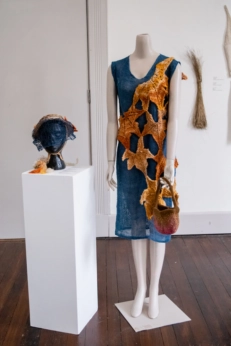
Amber Rose Ostaszewski lost count of the hours it took to produce this dress from flax using traditional methods. (Photo courtesy of the artist)
“With the exception of my flax brake, which my dad built based on antique flex brake plans, all of the equipment I own is antique,” she says. “It’s something I’ve either bought off eBay or found in a thrift store. The old-school style is just a ton—a ton—of work.”
Ostaszewski, who is an experienced spinner and weaver, spent the first three months of the project breaking down the flax stems, scraping off excess plant material and running what was left through beds of nails to separate the tangled fibers. (The latter two steps are known to insiders as “scutching” and “hackling.”) It took her a month to spin the yarn, two weeks to weave the fabric, a week to sew the dress and a week to dye it. She used every bit of the fiber she processed.
She’s not sure exactly how much time she wound up spending on that singular dress. About a month in, when she’d logged 180 hours and still had piles of flax to work through, she stopped counting.
Getting the industry off the ground
Most of the people aiming to turn North American linen from a cool idea into an actual industry say that money is the biggest barrier. They’re hopeful that once they’ve managed to design and buy the mid-sized machinery that will be needed to support production at any meaningful scale, everything else will fall into place.
The PA Flax Project and several groups like it have begun partnering with nearby farmers and gardeners to grow small volumes of organic flax and experiment with different ways of planting, tending and harvesting it. They’re wary of asking farmers to commit to more than that before a market exists for the crop. Already, though, farmers are starting to pay attention.
“They’re skeptical, still, on the payout, and how that works, as it kind of feels like we’re building an airplane in the sky,” says Jess Boeke, a high school English teacher and co-creator of the Ohio-based Rust Belt Linen Project. “But they’re very curious to hear more.”
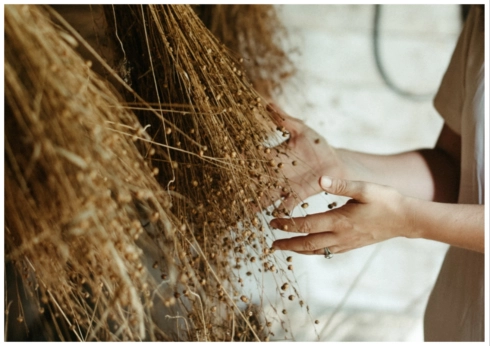
Dried flax plants—like these ones grown as part of the Rust Belt Linen Project—can be stored for years before being processed into linen. (Photo: Rust Belt Fibershed/Suzuran Photography)
Sarah Eichler, an assistant professor at Kent State University who studies agricultural sustainability, is also looking to fill in some of the gaps. It’s already known at this point that flax is “reasonably easy to grow,” she says. Her research explores where flax can be incorporated most effectively into existing crop systems.
While early signs suggest that flax would fit neatly into summer crop rotations with corn and soybeans, the precise benefits and any drawbacks remain to be determined. And although there’s also evidence that flax plants grown in moist regions could be particularly resilient to drought and unpredictable weather caused by climate change, more research will be needed to say for sure.
“By anyone’s standards, this would be the idea phase,” says Boeke. “What we’re doing this year is, by hand scale, creating proof of concept for how flax grows well here. But there’s no real proof of concept from a machinery standpoint yet.”
As linen’s proponents apply for agricultural grants and seek other sources of funding, they’re trying to make sure that when the machinery does finally reach North American shores, farmers will be ready to go.
Boeke, in particular, wants to make sure that as the industry matures, it remains committed to sustainable practices, not only for the land but for the people who tend to it.
“We have such an opportunity to do it differently,” she says, “and to do it well.”
Competition vs. collaboration
Growing and processing linen entirely in North America will require major investments in harvesting equipment that’s suitable for flax and in mills that are capable of extracting the fibers and spinning them into yarn. Some US weaving facilities are already capable of working with linen yarn, but space there is limited, too.
In total, the anticipated cost comes out to millions of dollars—an imposing number for linen enthusiasts who mostly have separate day jobs and are working out the logistics in their spare time.
Still, there’s a general consensus that the first commercial-scale mills are likely to open their doors and start turning out small batches of North American linen within the next five years.
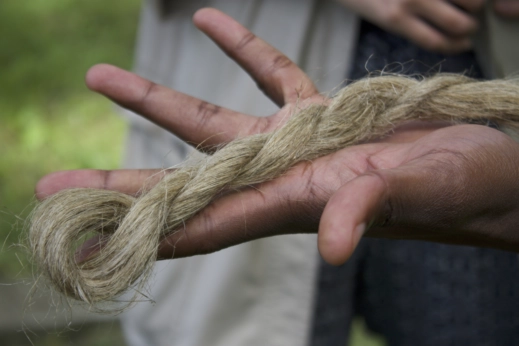
The fibers extracted from flax plants gave rise to familiar descriptors like “flaxen-haired” and “tow-headed.” (Photo: Rust Belt Fibershed/Lily Turner)
Some aspects of building a new industry around growing flax will be dictated by geography. But many will be universal. That’s why, in September 2022, the people behind the continent’s emerging regional linen projects established the North American Linen Association.
The trade organization is now working to import and build the needed machinery. It’s also become a sounding board for more experienced members and a source of information for newer ones. Instead of confronting the same challenges one by one, its members are beginning to deal with them together.
The North American Linen Association represents a major step toward commercialization, says Shannon Welsh, another founding member. Welsh co-founded Fibrevolution, a group whose work is aimed primarily at Oregon, in 2017. Hers was one of the first linen initiatives on the continent. Looking back now, she says , it’s easy to see how much progress North American linen has already made.
“We always wanted multiple mills to come online at the same time throughout North America, so that we could share resources, share experts—for the machinery, for fixing them, for problem-solving them—but also just to really create a supply chain,” says Welsh.
One day, she says, the regions could wind up in competition with one another. For now, however, she believes that collaboration is the best approach. “I think we have a lot more power that way,” she says. “We haven’t been in the world market for linen for many decades. And so, to reenter the market, it’s much stronger if we come united.”
Thanks for covering this topic!
Really interesting read. Thank you.
It is quite interesting. But the big question is “can it compete with COTTON crop these days with GM or BT cotton varieties”.
Could this work in conjunction with other plant fibers, especially hemp, which produces a similarly textured fiber.